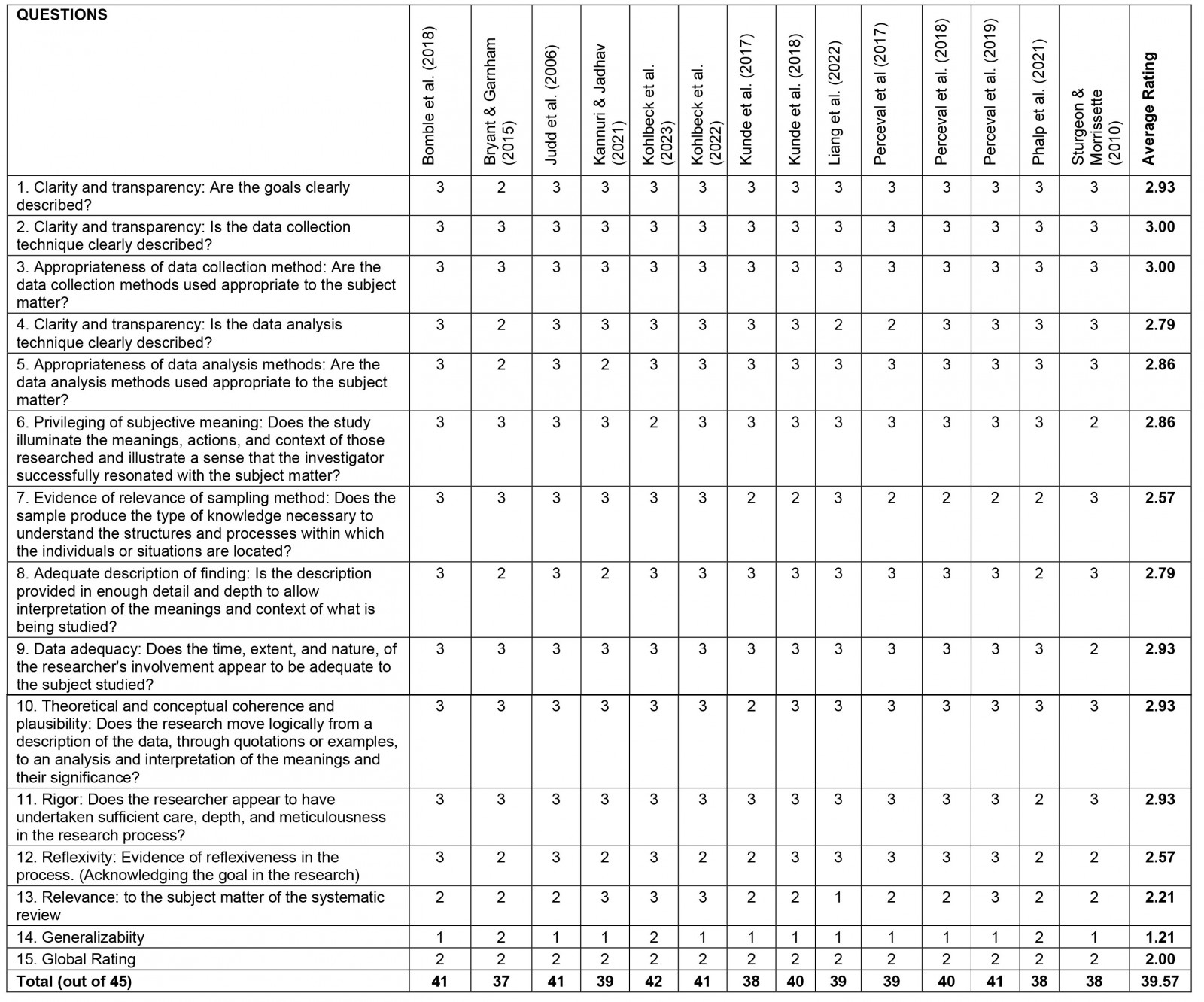Introduction
Suicide claims the lives of more than 700 000 people every year worldwide and is recognized as a serious public health concern1. Yet, suicide is not distributed evenly across populations. A previous meta-analysis reported that some occupations are linked to a higher suicide risk2. Farmers and agricultural workers – individuals who own, operate, or work on a farm of livestock or crops – have higher suicide rates than those working in other occupations. Similar findings have been reported in Australia3, Canada4, the US5 and the UK6. For example, data from the National Violent Death Reporting System in the US in 2016 revealed significantly higher suicide rates among individuals, particularly men who work in agriculture, forestry and fishing, compared to the national average5. Likewise, data from the Australian Bureau of Statistics showed 921 farm managers and agricultural laborers died by suicide between 1988 and 1997, representing about 92 deaths per year3. Yet, suicide rates among farmers may be even higher than what is reported. According to Beeson, stigma towards mental health, and cultural values of stoicism and self-reliance among farmers, may lead farm families to portray instances of suicide as accidents to avoid public scrutiny7. As farmer suicide is a universal phenomenon and an important public health concern, it is necessary to understand the risk and protective factors associated with it in order to develop and implement tailored interventions to those most at risk.
Farmers experience a range of personal and occupational stressors that place them at an elevated risk of suicide. The WHO’s social-ecological framework8 provides a framework for explaining the individual, interpersonal, community and societal factors influencing suicidal behavior. Indeed, most of the existing research on farmers can be categorized into one of these factors. For example, individual factors include injury, pain9,10, as well as poor mental health11,12. A national study of Canadian farmers reported that 57% met the criteria for anxiety, 34% for depression, and 62% experienced psychological distress11. Similarly, 42% of Finnish dairy farmers reported being stressed, and all were classified as having symptoms of burnout12. As farmer suicide rates are higher among men, some farmers may struggle with internalized expectations of masculinity that prevent them from seeking help13-15.
Interpersonal factors include geographical and social isolation16,17, as well as working with family18,19. For example, Truchot and Andela identified two farm-family stressors including conflicts with farm associates or family members about farm operations and professional values, and the fear of losing the ability to pass on the farm to subsequent generations20. Community factors include farm culture and living in rural areas, such as long working hours, equipment breakdowns21-23, crop failures24 and livestock disease outbreaks25. Farmers also have easy access to firearms9,26 and pesticides27. Additionally, rural communities often lack accessible healthcare services28,29. Broader societal factors include rising commodity costs, changes to government regulations and legislation, and environmental issues such as unpredictable weather20,21,23,30.
Despite these stressors, farmers have demonstrated that they can be resilient11,31. Resilience involves a process of recovering to baseline functioning following a major stressor, maintaining that functioning, and even growing beyond original levels of functioning32. At each level of the social-ecological framework exists possible protective factors, such as mental health literacy programs13, social supports and shared community identity31, and government programs33 – all of which may help farmers adapt to the ongoing stresses.
Since 2014, three systematic reviews26,34,35 and one meta-analysis with a narrative review36 have been conducted on farmer suicide. However, the reviews are limited in furthering our understanding of the factors associated with farmer suicide in that they included considerable heterogeneity in the samples studied34, included workers other than farmers36, or focused on farmers in Australia26. Moreover, the reviews included quantitative studies that used data gathered from regional mortality databases and focused exclusively on risk factors rather than possible protective factors. Therefore, it is currently unclear what chain of events might lead a farmer towards the path of suicide or what factors counteract the stressors. Further, no framework captures the dynamic and complex interplay of variables associated with suicide among farmers specifically.
A growing body of qualitative studies have investigated farmer suicide from the perspective of significant others, relatives or those working directly with farmers who died by suicide. Such data provide an opportunity to examine the underlying issues related to suicide from the perspective of individuals who have an intimate understanding of the life situation that led to suicide. Qualitative research can provide an in-depth, detailed picture about such experiences that surveys alone cannot easily capture. In an effort to fill this gap in the literature, we conducted a synthesis of qualitative research using meta-ethnography, which incorporates the strengths associated with quantitative reviews (eg systematic review, critical appraisal of studies), yet combines the direct words of participants by translating concepts across studies to produce a conceptual model37. The aim of our study was to understand the risk and protective factors associated with farmer suicide from the perspectives of their partner, relatives or individuals who worked closely with them, and to use this information to develop a conceptual model that explains the chain of events that might lead a farmer towards or away from the path of suicide.
Methods
We used Noblit and Hare’s meta-ethnography approach38 to synthesize qualitative findings across studies. Meta-ethnography was selected because it can be applied to a variety of qualitative methodologies and allows the reviewers to develop higher order constructs based on the re-interpretation of the themes and concepts created by the authors of the selected studies as well as the primary data (eg participant quotes) in those studies38. Thus, meta-ethnography is similar to what has been described as building third-order constructs (interpretations of the data by the reviewers) from second-order constructs (authors’ interpretations of primary data) that were created from first-order constructs (participants’ interpretations of their experiences)37.
Search strategy
In January 2023, we conducted a systematic search of electronic databases Embase, PsycINFO, Academic Search Complete, PubMed and Scopus. Our search was limited to studies published between 1980 and 2023 to capture relevant research on farmer suicide. We used a combination of search terms related to farming (farm*, agricultur*, rural), suicide ('self harm', suicid*) and qualitative methods ('qualitative', 'grounded theory', 'phenomenology', 'ethnography', 'discourse analysis', 'thematic', 'content analysis', 'narrative analysis'). We also reviewed reference lists of retrieved studies and published reviews.
Eligibility criteria
Studies had to focus on farmers or agricultural workers and include data on suicide from the perspective of significant others, relatives or individuals who worked closely with a farmer who had died by suicide. Studies could use any qualitative methodology, had to be written in English, have been published in a peer-reviewed journal or be a dissertation. Two reviewers independently screened titles, abstracts and full texts to determine suitability for the review.
Quality appraisal
Each study was critically appraised by two reviewers using a standardized form39. The form consisted of 15 questions about the study purpose, data collection, findings and scientific rigor. The questions are rated on a 3-point scale (where 0 is ‘unable to rate’ and 3 is ‘high quality’). The scores are summed and the total score may range from 0 to 45. Although quality appraisals are not always conducted for qualitative reviews, we included this step to encourage careful reading of the studies and to evaluate the studies. As there is no gold standard for determining the quality of a qualitative study40, we did not exclude any study based on its overall quality rating.
Analytical method
Using standardized forms, we extracted data from each study including general information (eg year published, research question), study characteristics (eg research design) and sample characteristics (eg age, education). Guided by Noblit and Hare’s meta-ethnographic process38, our analysis involved four steps: (1) carefully reading the selected studies to identify main concepts, (2) determining how the studies are related, (3) translating the studies into one another, and (4) synthesising the translations. First, two reviewers extracted key themes, ideas and concepts as expressed by the participants (ie first-order constructs) and authors (ie second-order constructs). We carefully read the studies to identify main concepts and ideas. Second, we examined the concepts across the studies to identify common ideas. Because there were so many concepts, we uploaded the data to NVivo v12 (QSR International; https://www.qsrinternational.com/nvivo-qualitative-data-analysis-software/home) and conducted a thematic analysis to create a list of themes from these first- and second-order constructs. Third, we compared the themes in one study with those of another while leaving the central theme intact. We began this process in chronological order, comparing the themes from the first study with those of the next study, and so on. During this process, our list of themes became more refined by merging themes. Discrepancies in the analysis were resolved through consensus. The final step involved a line of argument analysis whereby we reviewed all the themes we identified, mapped their interrelationships, then synthesized the data to identify new interpretations (ie third-order constructs) that could be applicable to all the studies. During this process, it became clear that the studies were reciprocal, or in agreement with one another, and not refutable or contradictory. We invited a panel of four experts with farming backgrounds (two farmers, two academics) to review our synthesis to help clarify our thinking about the data and the phenomenon of suicide for farmers.
Ethics approval
Approval from our institutional research ethics board was not required as data were already published.
Results
Search results
Following PRISMA guidelines41, our initial search yielded 6866 articles. After removing 116 duplicates and another 6568 for failing to meet the inclusion criteria, 182 studies were independently screened by two researchers. This process left 32 studies for full-text review. Common exclusion reasons included that the articles were quantitative (i.e., focused on suicide records), not focused on farmers or suicide, were conference abstracts, review studies, or editorials. Another 18 studies were removed after the full-text reading, resulting in a final sample of 14 studies9,16,17,42-52. The PRISMA diagram is presented in Figure 1.
Table 1 presents the study characteristics. The studies were conducted between 2005 and 2022. Half of the studies were conducted in Australia, and the remaining studies were conducted in India, Canada, the US and the UK. The studies included feedback from 802 individuals who were either significant others of farmers, or farmers themselves. Most of the farmers who died by suicide were men while the significant others were mostly women. The type of farm varied from cotton, wine, crop and livestock throughout the studies.
Table 1: Characteristics of studies included in the review9,16,17,42-52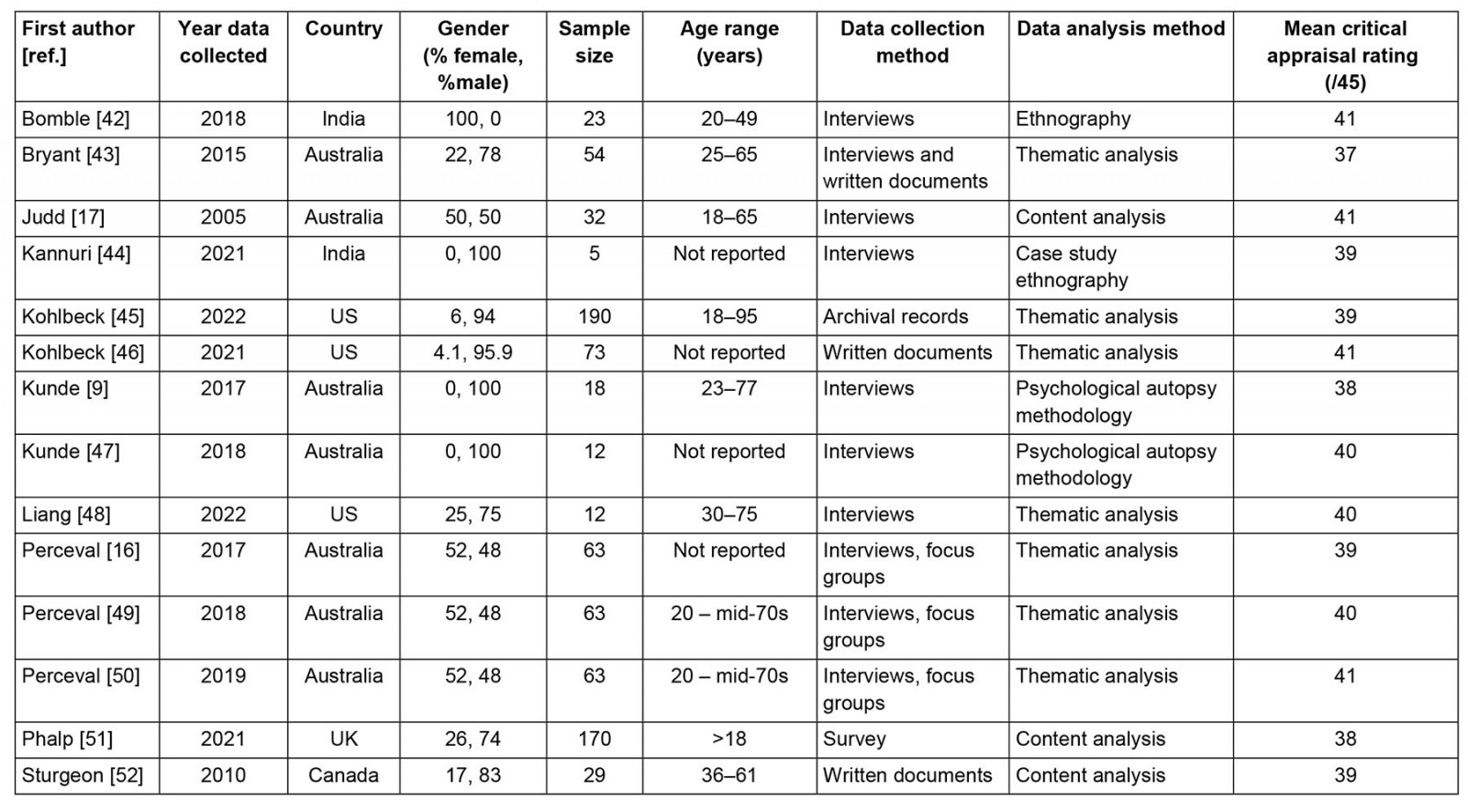
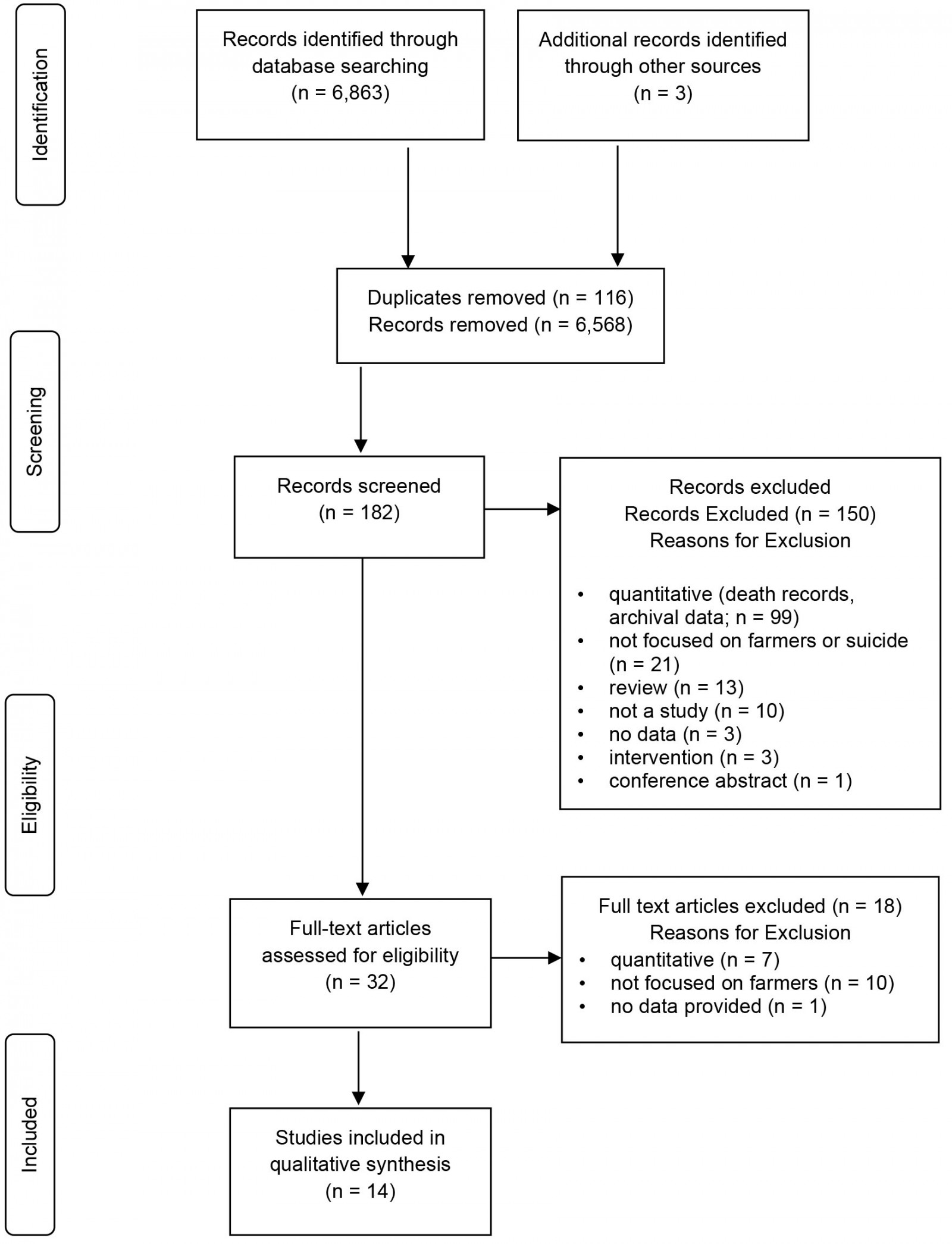 Figure 1: PRISMA diagram describing the process of selecting studies for the review.
Figure 1: PRISMA diagram describing the process of selecting studies for the review.
Quality appraisal results
The quality appraisal showed that most studies were rated moderately strong, with an average score of 39.6 (range 37–42). Most studies presented their goals, data collection and methods clearly. Nearly all the studies received lower scores for evidence of reflexivity, relevance and generalizability. The results of critical appraisal are presented in Appendix I.
Qualitative data synthesis
We identified seven themes. Each theme is discussed below with verbatim comments extracted from the studies to preserve the voice of the participants and to illustrate the nature of each theme. Table 2 presents the themes and subthemes in relation to each study.
Table 2: Themes and sub-themes identified within each of the included studies9,16,17,42-52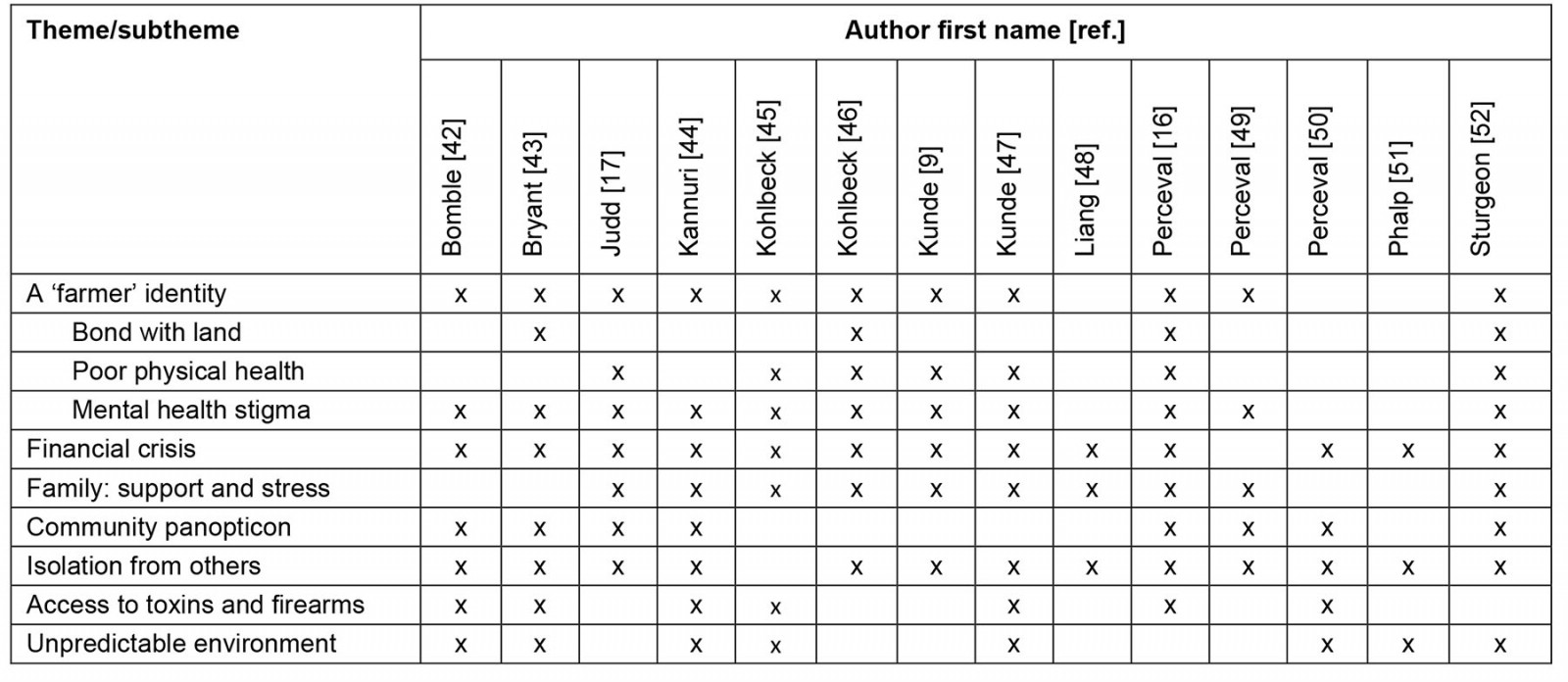
Maintaining a ‘farmer’ identity: Farmers who died by suicide, particularly men, were described as hard-working, strong, private people who took great pride in being the stoic breadwinners of their families. They were often remembered as members of a unique and fading culture who were poorly understood by outsiders. In many cases, the farm had been passed down through generations and farming was a job and a lifestyle. According to their partners, if the farm failed then the farmer believed that they failed, and they could not imagine themselves working in any other job. These qualities are illustrated by the following quote:
I think it is when we identify ourselves with what we do and that becomes who we are and then when you see that potentially slipping away … you get lost … I think you lose that sense of who you are (p. 385)16.
We further identified three subthemes that reinforced this theme.
Bonded to the farm The farmers who died by suicide were described as having a deep connection to their farm, the land and everything on it. When faced with challenges or setbacks, farmers felt ashamed they had failed when previous generations had succeeded and blamed themselves if they could not pass on the family legacy. This bond with the farm was further highlighted as the suicides occurred on the farm, usually triggered by foreclosure or repeated crop failure, as illustrated in the following example:
His farm was lost due to financial difficulties … Incident [the suicide] occurred on farm property, near a machine shed. The farm had formerly belonged to [the decedent] but was recently foreclosed and sold to new owners (p. 5)45.
Physical health issues In the months leading to their suicide, many experienced physical health conditions such as fatigue, chronic pain and high blood pressure that limited their ability to function as they used to. In some cases, their declining health was from years of physical labor or a series of cascading events in short succession. One author described that when ‘drought ensued, expenses increased (eg buying water); consequently, workload increased, [and] incidents of physical illness/injury increased’ (p. 257)46. The inability to perform made them feel useless, burdensome and without purpose. The link between failing physical health affecting mental health is highlighted by the following quote: ‘He did his back. The doctor said he wouldn’t be able to shear again, so he felt if he couldn’t do shearing he couldn’t do anything’ (p. 385)16.
Mental health stigma Many were either diagnosed with or showed symptoms of depression, anxiety or distress at the time of their death. However, a strong sense of pride and maintaining the appearance of coping through adversity prevented many from seeking help or even talking about their problems. Some also believed that ‘outside people’ or counsellors would not understand them, while others struggled to find the words to describe their emotions. As one farmer explained:
Oh yes it's very easy to go to the Dr for a broken bone or a rash or a cut or something but something in the head no, no, no. Strong farming men they don't suffer from mental illness, none of that sort of business (p. 7)17.
Instead of seeking help, many hid their problems. One wife explained that ‘You try to be strong when you’re out and then get depressed when you’re at home’ (p. 6)17. Three studies noted that farmers coped by drinking alcohol, or taking prescription drugs or cannabis16,17,48.
Financial crisis: Farmers who died by suicide tended to experience a series of significant challenges and setbacks that accumulated into financial crisis with a sense of no way out. Uncontrollable events such as changes in market regulations or government legislation, repeated crop failures or livestock issues left farmers stressed, with mounting debt. A relative of a farmer explained:
Our loans mounted and my brother started blaming himself for the situation. One day he went to the fields and never came back. His body was found in the fields the next day (p. 562)44.
Feeling unable to reach financial stability and possibly losing the family farm and their livelihood could be overwhelming. A White male farmer aged 57 years left a suicide note saying that ‘he seemed to be working all the time and never catching up’ (p. 5)45.
Family: support and stress: Family could be a major reason for a farmer not following through with suicide. In these circumstances, the farmer viewed themselves as a contributing member of the family and not ‘just a farmer’. As one farmer mentioned, ‘I just keep going because I think someday my son will need me’ (p. 199)50. Yet, partners were not always viewed as reliable sources of support in the same ways as their own relatives. Many farmers who died had been recently separated or divorced from their partner. Moreover, the enmeshed work–home relationship meant that the family was deeply invested in the business. In instances of drought and repeated crop failures, farmers viewed themselves as a burden to their family if they could not pass on the farm to their children or pay family members. This point is illustrated by this comment: ‘Farmers stated that they were a liability to [their] family of origin and a failure to [their] children (eg let father down, children had turned against them)’ (p. 257)46.
The community panopticon: Originally, a panopticon referred to the central tower in a prison that allowed the guard to easily monitor individuals in the surrounding cells53. The term has since been used as a metaphor of social control whereby individuals are always surveilled without realizing it53. In many ways in this research, the farmer’s rural community served as a panopticon, representing both a protective and risk factor. For example, the community helped farmers stay socially integrated through local events. Yet, the community was also a source of stress as farmers felt their decisions would be seen and judged by others. This point is illustrated by the following quote:
If you’re a farmer and you irrigate a different way … it is very, very obvious and you have to be very confident that it’s going to work before you’d consider changing anything because yes, everyone in the district would know within 24 hours if you’ve changed something … and they’ll be wanting to know why you’ve decided to do that and you have to justify that (p. 5)17.
The community also cast moral judgments and perpetuated negative attitudes towards mental health issues, all of which further reinforced notions of the tough farmer culture.
Isolation from others: Farmers commonly experienced geographic, social and emotional isolation. With some farms being large and dispersed across the region, farmers experienced limited interactions with neighbors. Depending on the remoteness of the farm, telecommunications could be poor, and many spent long hours working alone with no one to share their thoughts, concerns or fears with. Farmers valued having someone to talk to as the following quote illustrates:
If you are feeling isolated from your family and you have no one who really knows you in order to ask the right questions – ‘are you okay?’ … it does make you feel isolated (p. 4)48.
As another farmer noted, ‘You can’t talk to a GP in as much as it takes 3 weeks to get in for an appointment and you’ve forgotten it or gotten over it or got worse’ (p. 7)17.
Access to toxins and firearms: Farmers have easy access and are familiar with pesticides and firearms as they may be a part of regular farm work (eg controlling pests, euthanizing livestock). Without access to mental health supports to help farmers deal with their stress, some farmers may believe that suicide is a logical solution to their problem. As this farmer notes:
That may be why suicide is at a higher rate in the country, because we do that (use %uFB01rearms) on a daily basis anyway. It’s an identified end to a problem for everything else (p. 282)49.
An unpredictable environment: In recent years, farmers have endured a variety of uncontrollable events such as changes in market regulations or government policies, volatile weather, and pests and livestock epidemics. These events have forced farmers to adjust their farming practices from what they have historically done, placing them in unfamiliar territory. Changes in market regulations and new government policies may force farmers to change the way they farm in order to maintain their farming license. Government policies may also be a protective factor if there are subsidies and price guarantees. While drought, crop failure or livestock diseases are relatively common farming occurrences, experiencing them repeatedly can lead to feelings of hopelessness. One participant mentioned:
When you get up in the morning and you’ve got to go out … and you’re seeing all these dead animals consistently every day and having to shoot the cows, shoot the calves every single day, no days off. This went on for nearly two years … it wears you down (p. 282)49.
Generating a framework
Understanding the nature of farmer suicide requires moving beyond the individual (eg traits, age, gender) and situating the farmer within the broader social context. We generated a framework that connected the themes identified in our analysis in a meaningful way to understand why some farmers die by suicide while others do not. Our framework is called the Farming Adversity-Resilience Management framework (FARM framework). As shown in Figure 2, farming is associated with two primary goals that are represented as intersecting rings: maximizing production and maintaining the family farm. The y-axis represents the resilience continuum for managing adversity, and we have identified particular resilience zones: excelling, coping, at risk and in crisis. The intersecting nature of the rings symbolize how one system can impact the other, and vice-versa. For example, a series of crop failures due to a drought impacts productivity but may also negatively impact ability to maintain the family farm, putting the farmer’s mental health at risk if they do not have or use protective factors to assist them.
The ring shape itself represents the general ebb and flow of farming, which is characterized by periods of growth, stability, breakdown and change. For example, the growth period occurs when work and family are productive. The growth period is followed by a period of stability whereby the farmer develops habits and a fixed pattern of work practices. Sometimes these practices are passed from generation to generation because they have traditionally been successful. However, the period of stability ends when a triggering event threatens one of the goals. For farming, the triggering event might be a regulation change or a drought. For family, it may be a separation or farm succession transition. In either case, previously used practices are no longer effective and lead to a breakdown, as denoted by the downward arrow. The breakdown resembles burnout, which refers to a state of feeling emotional, physical and mental exhaustion due to prolonged stress, and consists of three components: feeling emotionally and physically exhausted, being cynical and lacking an interest in work, and feeling ineffective54. A farmer can recover from a breakdown and transition back to a growth period through a variety of protective factors. Using the support, they build their resilience so that they are less susceptible to challenges in the future. However, if they resist using supports or there are none available, transitioning to a growth period places them at risk for poorer mental health and even suicide. Thus, rather than returning to a growth period, farmers ‘get stuck’ in a perpetual downward cycle that they find difficult to come out of by themselves.
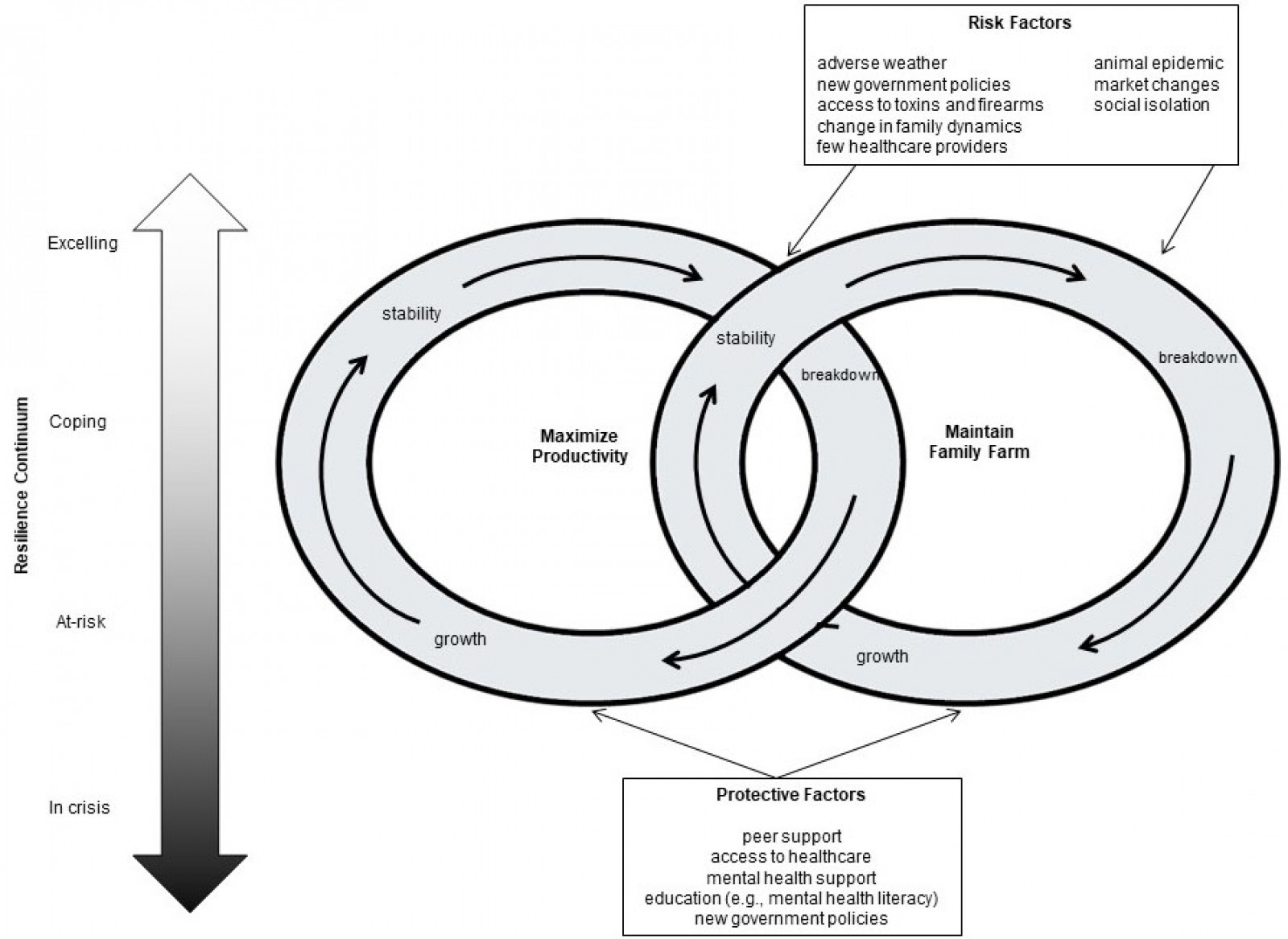 Figure 2: The Farm Adversity-Resilience Management (FARM) framework for understanding farmer suicide.
Figure 2: The Farm Adversity-Resilience Management (FARM) framework for understanding farmer suicide.
Discussion
To our knowledge, this is the first research synthesis that leverages qualitative data from individuals who had personal insight to describe the context of farmers’ lives before they died by suicide. Our review uncovered several dynamic relationships between risk and protective factors. First, farming has long been associated with a range of ongoing stressors but the dose of these stressors may have contributed to burnout. Second, there was a strong connection between masculinity and help-seeking. Third, financial stressors may have led some farmers to feel trapped or stuck in a hopeless situation. Fourth, social support from partners, relatives and the community can represent both a stressor and a protective factor. We developed a conceptual model that incorporated these factors to create a coherent narrative to describe the circumstances that might motivate some farmers to die by suicide while others do not.
While farming has long been associated with a range of ongoing stressors20, those farmers who died by suicide were described as having heavy workloads, working long hours, and dealing with major time pressures and personal issues such as marital conflicts or chronic pain. The cumulative impact of many work–life stressors in close succession may have led to burnout. Within the agricultural literature, burnout is a relatively new area of research11,12. A study of 1075 Canadian farmers (70% male) reported scores on exhaustion, cynicism and professional efficacy higher than normative scores55. Moreover, 44% of the farmers were classified as at risk for burnout while 12% met the criteria for burnout55. While the link between burnout and suicide among farmers has not been explored, research on physicians has found that burnout was related to higher levels of substance abuse, depression and suicidal thoughts56.
In terms of help-seeking for psychological distress, traits such as stoicism, independence and a strong desire to keep matters private – traits used to describe traditional ideals of farmers – may be maladaptive. We found a strong connection between farming men, masculinity and help-seeking. Specifically, those who died by suicide were commonly described as stoic, strong and doers who did not use medical or mental health support despite experiencing a lot of stressors. While farmers often face structural barriers, such as limited availability of services in their area, seeking mental health help remains highly stigmatized among farmers13. A recent study found that older White men who endorsed hegemonic masculinity ideals (eg men should be strong, unemotional and financially secure) were more likely to experience internalizing (eg depression) and externalizing (eg anger) mental health problems56. Moreover, these correlations were stronger for men who perceived their health was declining and for men who had lost wealth57.
Consecutive years of poor crop yields, livestock epidemics or unexpected equipment breakdowns impacted farmers financially, leaving many to feel trapped or stuck in a hopeless situation. While indebtedness was a common stressor for farmers who died by suicide from different geographical contexts, farmers from India experienced this much more intensely and their mental decline appeared much more rapid than farmers in Western countries. In particular, farmers struggling in India also upheld masculine ideals but were described as having amplified feelings of humiliation42,43, whereas farmers in Western countries were described as experiencing shame43,45. While shame and humiliation are forms of distress that make us self-conscious, shame refers to a personal sense of failure and a global sense of deficiency58, whereas humiliation includes these components as well as a relational component whereby the individual feels degraded59.
An interesting finding was that partners, family and community represented both a stressor and a protective factor. Previous research on farmers has shown that social support and a sense of belonging were associated with fewer symptoms of depression60-62 and suicidal ideation61. These results highlight the importance of social support from friends and family members in preventing depressive symptoms and suggest that telemental health may be an alternative to face-to-face counseling to provide outreach mental health services to rural farmers. Moreover, rural communities have long been associated with closeness and solidarity63. However, we found that the rural community was also a source of stress in that everyone knows everything. Philo et al refer to this as the ‘rural panopticon’64. In their study of mental health service users in the Scottish Highlands, participants expressed that they felt their lives were not entirely private and living in a rural setting was similar to living in a glass bowl64. Indeed, the thought of being the subject of community gossip motivated many to keep their mental ill health a secret.
Our conceptual model illustrates the circumstances that lead some farmers to die by suicide while others do not. We framed our model to reflect two broad goals of farming that revolve around values, beliefs and practices of maximizing production and maintaining the family business65,66. Our model acknowledges that farming is characterized by ongoing and unpredictable stressors that can negatively impact one or both dimensions, and that resources and supports such as access to mental health services, education and social support can buffer these stressors. While our model is consistent with quantitative data regarding risk factors26,34-36 as well as some concepts with other prominent suicide theories, such as perceived burdensomeness (ie their existence burdens family, friends and/or society) in Joiner’s interpersonal-psychological theory of suicidal behavior0, our model moves beyond individual factors by situating the farmer in a broader social context.
Limitations
While we collected data from 14 studies across five countries and had enough data to reach data saturation, several limitations warrant mention. First, our review included seven studies from Australia, of which three drew upon the same sample. Also, we intended to generate findings and a model that could be applied broadly, but our results may not generalize to other geographical contexts. Furthermore, there was not enough data to examine possible differences across farming commodity types. Although a recent quantitative study showed no significant differences in burnout, mental health problems and resilience across commodity groups55, this study was conducted in Canada. It is possible that there are intersecting factors across commodity types and countries that influence suicidal behaviour that need to be explored. Our findings highlighted several gaps in the literature. Further research is needed to validate our findings, and our conceptual framework can guide future research.
Implications
Mental health literacy programs may be a useful tool to prevent suicide among farmers. Mental health literacy programs developed specifically for farming populations have successfully increased farmers’ general mental health knowledge, improved attitudes towards those struggling with mental health, and increased helping behaviors13. Farmers may also benefit from psychological counselling, especially from counsellors who are familiar with farming13. However, farmers often have to pay out-of-pocket for these services13. Policymakers and insurance companies should consider ways of reducing the financial barriers of psychological counselling. Furthermore, healthcare providers should be aware of the common stressors farmers face and incorporate questions into their consultations to better assess a farmer’s level of distress. Also, government programs could reduce the financial hardships for farmers. For example, changes could include offering subsidized crop insurance to protect farmers from financial losses due to poor harvests.
Conclusion
Our review found that the farmers who die by suicide may represent a subset of farmers, particularly men, who experienced the mounting pressure of unpredictable work–life circumstances and did not access or have access to protective factors. The inability to manage these stressors may have contributed to burnout and a sense of hopelessness to turn their situation around on their own. Understanding the stressors and developing resiliency factors that provide farmers with the tools to manage their occupational stressors should be a central focus for public health researchers and policymakers.
Funding
This research received no funding.
Conflict of interest
The authors declare that they have no affiliations with or involvement in any organization with any financial interest (eg honoraria, awards or grants) and have no personal or professional relationships related to the subject matter discussed in this manuscript.



